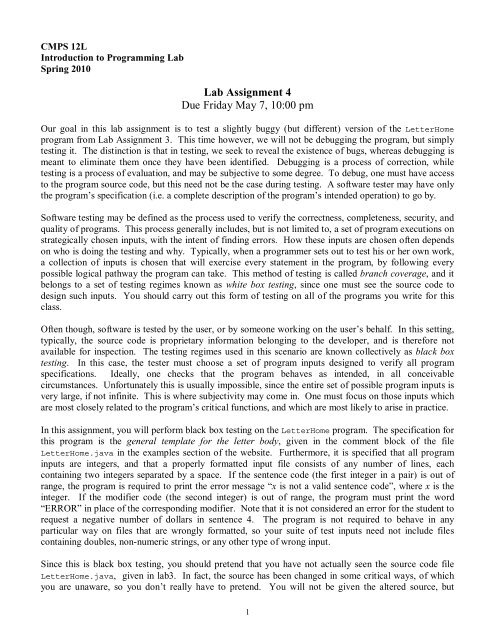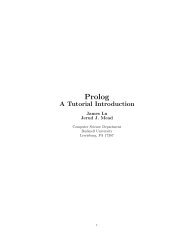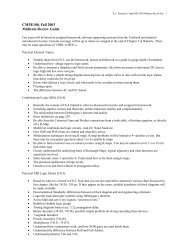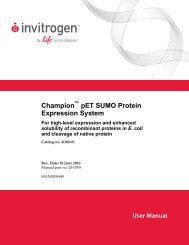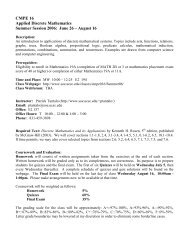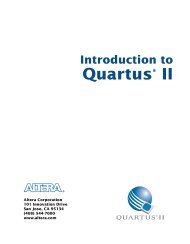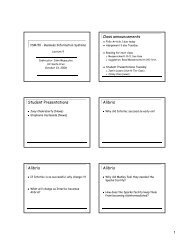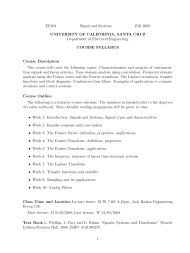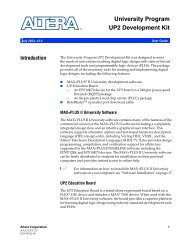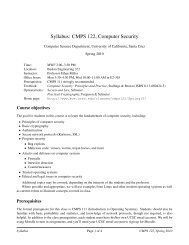Lab Assignment 4 Due Friday May 7, 10:00 pm - Courses
Lab Assignment 4 Due Friday May 7, 10:00 pm - Courses
Lab Assignment 4 Due Friday May 7, 10:00 pm - Courses
Create successful ePaper yourself
Turn your PDF publications into a flip-book with our unique Google optimized e-Paper software.
CMPS 12L<br />
Introduction to Programming <strong>Lab</strong><br />
Spring 20<strong>10</strong><br />
<strong>Lab</strong> <strong>Assignment</strong> 4<br />
<strong>Due</strong> <strong>Friday</strong> <strong>May</strong> 7, <strong>10</strong>:<strong>00</strong> <strong>pm</strong><br />
Our goal in this lab assignment is to test a slightly buggy (but different) version of the LetterHome<br />
program from <strong>Lab</strong> <strong>Assignment</strong> 3. This time however, we will not be debugging the program, but simply<br />
testing it. The distinction is that in testing, we seek to reveal the existence of bugs, whereas debugging is<br />
meant to eliminate them once they have been identified. Debugging is a process of correction, while<br />
testing is a process of evaluation, and may be subjective to some degree. To debug, one must have access<br />
to the program source code, but this need not be the case during testing. A software tester may have only<br />
the program’s specification (i.e. a complete description of the program’s intended operation) to go by.<br />
Software testing may be defined as the process used to verify the correctness, completeness, security, and<br />
quality of programs. This process generally includes, but is not limited to, a set of program executions on<br />
strategically chosen inputs, with the intent of finding errors. How these inputs are chosen often depends<br />
on who is doing the testing and why. Typically, when a programmer sets out to test his or her own work,<br />
a collection of inputs is chosen that will exercise every statement in the program, by following every<br />
possible logical pathway the program can take. This method of testing is called branch coverage, and it<br />
belongs to a set of testing regimes known as white box testing, since one must see the source code to<br />
design such inputs. You should carry out this form of testing on all of the programs you write for this<br />
class.<br />
Often though, software is tested by the user, or by someone working on the user’s behalf. In this setting,<br />
typically, the source code is proprietary information belonging to the developer, and is therefore not<br />
available for inspection. The testing regimes used in this scenario are known collectively as black box<br />
testing. In this case, the tester must choose a set of program inputs designed to verify all program<br />
specifications. Ideally, one checks that the program behaves as intended, in all conceivable<br />
circumstances. Unfortunately this is usually impossible, since the entire set of possible program inputs is<br />
very large, if not infinite. This is where subjectivity may come in. One must focus on those inputs which<br />
are most closely related to the program’s critical functions, and which are most likely to arise in practice.<br />
In this assignment, you will perform black box testing on the LetterHome program. The specification for<br />
this program is the general template for the letter body, given in the comment block of the file<br />
LetterHome.java in the examples section of the website. Furthermore, it is specified that all program<br />
inputs are integers, and that a properly formatted input file consists of any number of lines, each<br />
containing two integers separated by a space. If the sentence code (the first integer in a pair) is out of<br />
range, the program is required to print the error message “x is not a valid sentence code”, where x is the<br />
integer. If the modifier code (the second integer) is out of range, the program must print the word<br />
“ERROR” in place of the corresponding modifier. Note that it is not considered an error for the student to<br />
request a negative number of dollars in sentence 4. The program is not required to behave in any<br />
particular way on files that are wrongly formatted, so your suite of test inputs need not include files<br />
containing doubles, non-numeric strings, or any other type of wrong input.<br />
Since this is black box testing, you should pretend that you have not actually seen the source code file<br />
LetterHome.java, given in lab3. In fact, the source has been changed in some critical ways, of which<br />
you are unaware, so you don’t really have to pretend. You will not be given the altered source, but<br />
1
instead, you will have only the corresponding executable object file LetterHome.class to work with.<br />
You should copy this file from /afs/cats.ucsc.edu/courses/cmps012a-pt/ to your own account<br />
space. Begin by creating a directory within your cs12a directory called lab4, then cd to that directory<br />
and do<br />
% cp /afs/cats.ucsc.edu/courses/cmps012a-pt/LetterHome.class .<br />
Be sure to include that final dot, which means “the directory I am now in”. This command copies the<br />
object file LetterHome.class to your lab4 directory, giving it the same name. Be sure not to copy this<br />
file to your lab3 directory, or wherever you keep your corrected object file from that assignment, since<br />
the cp command will overwrite any file having the same name. The point is that LetterHome in this<br />
assignment is a different program than LetterHome in lab3.<br />
Once you have the executable, design an input file (or files) to thoroughly test each aspect of the<br />
specifications outlined above. Notice that, even for this simple program, the set of possible inputs is<br />
infinite, since the number of dollars requested by the student in sentence 4 could be any integer (even a<br />
negative one) . This poses a problem for you, the tester, since for all you know, the program will crash<br />
when the dollar amount 6732 is entered, and for no other amount. You must use your best judgment in<br />
selecting these test inputs. Your test file(s) should elicit a number of errors from the program, which are<br />
defined to be any departure from the above specifications. Look closely at the output since these could be<br />
just minor grammatical errors. Create a text file called errors containing a numbered list of the errors<br />
you found in the executable LeterHome.class. Include a short one or two sentence description of each<br />
error. Your description should in no way refer to the source file for the program, since after all, you don’t<br />
(really) have that. Instead, just say in what way the specifications were violated.<br />
Submit your file errors, along with any test files you created for this assignment to the lab4 submit<br />
directory:<br />
% submit cmps012a-pt.s<strong>10</strong> lab4 errors test_file1 test_file2 . . .<br />
You may find this to be one of the easiest labs to complete, but it will take some time to do it carefully, so<br />
please do not wait until the last minute to begin.<br />
2


